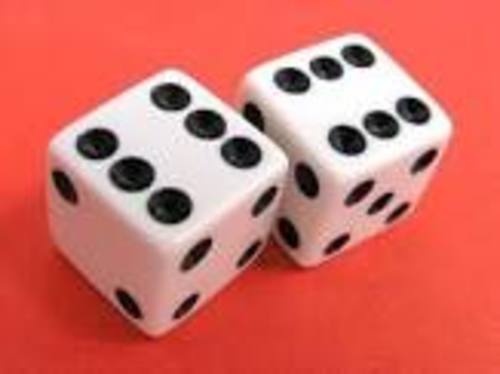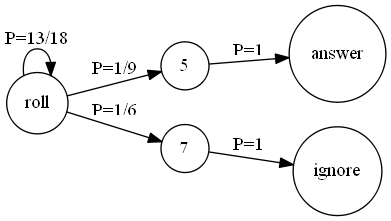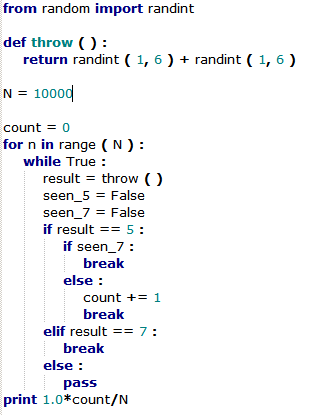Do you play dice games?
 Independent trials, consisting of rolling a pair of fair dice, are performed.
Independent trials, consisting of rolling a pair of fair dice, are performed.
What is the probability that an outcome of 5 appears before an outcome of 7?
Here, outcome of a roll is the sum of the numbers on the dices.
You can try my other Probability problems by clicking here
The answer is 0.4.
This section requires Javascript.
You are seeing this because something didn't load right. We suggest you, (a) try
refreshing the page, (b) enabling javascript if it is disabled on your browser and,
finally, (c)
loading the
non-javascript version of this page
. We're sorry about the hassle.



The probability of an outcome of 5 is 9 1 , and the probability of an outcome of 7 is 6 1 . Thus the probability of an outcome other than 5 or 7 is
1 − ( 9 1 + 6 1 ) = 1 8 1 3 .
We now need to calculate the sum of the probabilities of getting an outcome other than 5 or 7 for k throws and then throwing a 5 on the ( k + 1 ) st throw, where k goes from 0 to ∞ . This sum will be
9 1 + ( 1 8 1 3 ) ( 9 1 ) + ( 1 8 1 3 ) 2 ( 9 1 ) + . . . . . =
( 9 1 ) ∗ ∑ k = 0 ∞ ( 1 8 1 3 ) k =
( 9 1 ) ∗ 1 − 1 8 1 3 1 = ( 9 1 ) ( 5 1 8 ) = 5 2 = 0 . 4 .
Alternately, we could use conditional probabilities. Someone else would roll the dice repeatedly until they get an outcome of either 5 or 7 . They would inform us of this event, without telling us which outcome occurred. We would then ask ourselves, "Given that an outcome of 5 or 7 has occurred, what is the probability that it is a 5 ?"
We would then use Baye's Theorem to find that
P(outcome of 5 | a 5 or 7 has been rolled) =
P ( 5 ) + P ( 7 ) P ( 5 ) = 9 1 + 6 1 9 1 = 1 8 5 9 1 = 5 2 = 0 . 4 , as found before.